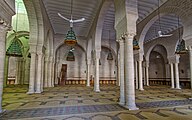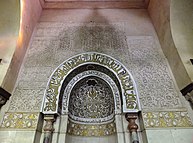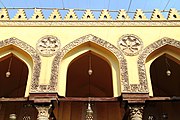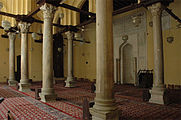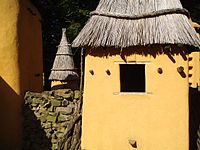Fatimid architecture


The Fatimid architecture that developed in the Fatimid Caliphate (909–1167 CE) of North Africa combined elements of eastern and western architecture, drawing on Abbasid architecture, Byzantine, Ancient Egyptian, Coptic architecture and North African traditions; it bridged early Islamic styles and the medieval architecture of the Mamluks of Egypt, introducing many innovations.
The wealth of Fatimid architecture was found in the main cities of Mahdia (921–948), Al-Mansuriya (948–973) and Cairo (973–1169). The heartland of architectural activity and expression during Fatimid rule was at al-Qahira (Cairo), on the eastern side of the Nile, where many of the palaces, mosques and other buildings were built.[1] Large-scale constructions were undertaken during the reigns of al-Mui'zz (r. 953–975) Al-Aziz Billah (r. 975–996) and al-Hakim (r. 996–1021).[2]
The Fatimid caliphs competed with the rulers of the
Although heavily influenced by architecture from
Many of features and techniques of Fatimid architecture continued to be used in the architecture of their successors, the
| Part of a series on |
| Arabic culture |
|---|
 |
Background
Origins

The
Ifriqiya
Mahdia was a walled city located on a peninsula that projected into the Mediterranean from the coast of what is now Tunisia, then part of Ifriqiya.
Al-Mansuriya, near
After the Fatimid conquest of Egypt in 969, the caliph al-Mu'izz moved from the city to the new city of al-Qāhira (Cairo) in 973, but al-Mansuriya continued to serve as the provincial capital.[14] In 1057 it was abandoned and destroyed. Any useful objects or materials were scavenged during the centuries that followed. Today only faint traces remain.[15]
Egypt
The Fatimid general,
Some of the most impressive, large-scale Fatimid mosques and palaces were built in Cairo under during the reigns of al-Mu'izz and his successors, al-Aziz and al-Hakim.[2] The reign of Al-Aziz (r. 975–996) is generally considered to have been the most prosperous.[17] Aided in part by funds generated through his father al-Mu'izz's tax reforms, Al-Aziz is credited with at least 13 major building works during this reign, including palaces, a mosque, a fortress, a belvedere, a bridge and public baths.[17] He was responsible for building and expanding much of the great palace complex in Cairo that had been first established under his father. Among other works, he built the Western Palace and ordered the construction of further additions to the Eastern Palace complex, including the "Great Hall" (al-Iwan al-Kabir) and the "Golden Palace" (Qasr al-Dhahab).[18] He also began construction of a large mosque which was completed after his death by his successor, al-Hakim.[19] Under al-Aziz's rule the ceremonial aspects and rituals involving the Fatimid imam-caliph became more elaborate. In contrast to Abbasid practices in Baghdad, in which the caliph's activities were generally confined to the palace, Fatimid ceremonial practices became increasingly integrated with the surrounding urban environment of Cairo. The imam-caliph often went on processions through the city and visited mosques and shrines, including newly-built monuments sponsored by the ruler or his family.[20]
Al-Aziz's mother,
Fatimid fortunes declined in the mid-11th century, but order was temporarily restored by a line of powerful viziers in the late 11th century.[2] The Armenian vizier Badr al-Jamali was a noted builder, sponsoring numerous state architectural projects and restoration works during his rule from 1074 to 1094, particularly with mosques, restoring minarets in Upper Egypt and building mosques in Lower Egypt.[22] He also rebuilt the walls and gates of Cairo. While large-scale mosques and major public works were rare during this later period, smaller mosques and new commemorative shrines (mashhads) attest to the maintenance of a high standard of craftsmanship in art and architecture.[2]
Architectural style

Fatimid architecture drew together decorative and architectural elements from the east and west, and spanned from the early Islamic period to the Middle Ages, making it difficult to categorize.
According to Ira M. Lapidus, public architecture under the Fatimids was an "extension of the ceremonial aspects of the royal court", and was also intricately made.[30] Most early buildings of the Fatimid period were of brick, although from the 12th century onward stone gradually became the chief building material.[31] While Fatimid architecture followed traditional plans and aesthetics, it differed in architectural details such as the massive portals of some mosques and their elaborate façades.[29] Scholars such as Doğan Kuban describe Fatimid architecture as "inventive more in decoration than in broad architectural concept", although he acknowledges that the Fatimids contributed to a distinct style of mosque.[32] The Fatimids introduced or developed the usage of the four-centred keel arch[b] and the muqarnas squinch, a feature connecting the square to the dome. The muqarnas squinch was a complex innovation. In it a niche was placed between two niche segments, over which there was another niche. It is possible that this design had Iranian inspiration. A similar system was applied to window building.[33]
Fatimid architecture in Cairo also displays certain trends in surface decoration. While Samarran (Abbasid) and Byzantine motifs were major sources of inspiration, Fatimid ornamentation evolved to be less repetitive, more complex, and more specially tailored to suit the surface being decorated.
Palaces
The palaces of the Fatimid caliphs, their greatest architectural achievements, have been destroyed and are known only from written descriptions and archeological evidence.[34][36]
Palaces of Mahdiya

Historical sources describe Mahdiya as having multiple Fatimid palaces. From the city's main gate a central avenue led to a public square surrounded by three palaces. The palace on the east side, called the Dar al-'Amma, was used for official purposes. Another to the north was the private palace of Caliph al-Mahdi, and another to the south was for his son, Abu'l-Qasim (later enthroned as al-Qa'im).[37] Unlike most palatial cities of the time, these palaces were located close to the coast, overlooking the sea.[37] One of the palaces had a Great Hall, known as the Iwan al-Kabir ("Great Iwan").[38] Another reception hall, the Majlis al-Baḥr ("Hall of the Sea" or "Maritime Hall") was built next to the harbour itself to host receptions related to the Fatimid navy.[37] The palaces were all built in high-quality white limestone, which was available locally.[37] Some probable fragments of the palace have been found in the city: some columns and capitals were found re-used in later houses and a large mosaic pavement has been excavated. The mosaic pavement features geometric motifs.[38]
Of the three main palaces, only remains of the southern palace have been found. It measured around 85 by 100 metres (279 by 328 ft) and had round corner towers and semi-round buttresses along its outer walls.[37] Inside, it probably had a large central courtyard, though few remains of this have been uncovered. On the north side of this courtyard was a large reception hall of rectangular shape divided into three naves by two rows of pillars or columns. At the back end of the central nave was a small apse where the throne of the crown prince probably stood. Reception halls or throne halls with a similar layout were found in the older Aghlabid palace at Raqqada and in the later Cordoban Umayyad palatial city of Madinat al-Zahra.[37] According to scholar Felix Arnold, the proportions of this hall correspond to an equilateral triangle, with the throne apse situated at one corner of this triangle. Arnold suggests that the equilateral triangle, which was often employed by Islamic artists and architects, was important because its proportions provided the figure on the throne (at one end of the triangle) with an optimal field of view over the rest of the hall. Similar proportions are found in later throne halls in the western Islamic regions, including those of Madinat al-Zahra, but this is the earliest known application of this design in the region.[37]
Sabra al-Mansuriyya
In 946 the Fatimids began construction of the new capital named al-Mansuriyya (after its founder, the third Fatimid caliph al-Mansur), at a site called Sabra near Kairouan.
Great Palaces of Cairo

The heartland of architectural activity and expression during Fatimid rule was Cairo, where many of the palaces, mosques and other buildings were built.[1] The Caliphs competed with their rivals of the Abbasid and Byzantine empires, and were known to indulge in furnishing their palaces with "extraordinary splendor".[30] The sprawling palatial complex at the heart of Fatimid Cairo consisted of two major palaces: the Eastern Palace or Great Palace (al-Qasr al-Kabir) and the smaller Western Palace or Lesser Palace (Qasr al-Saghir al-Gharbi).[18] The two palaces were separated by a main street that ran roughly north-to-south – the present-day al-Mu'izz Street – and at the center between was a large public square, Bayn al-Qasrayn (literally, "Between the Two Palaces"), which was the heart of the city and a site of certain ceremonies. The grand entrance to the Eastern Palace, the Golden Gate (Bab al-Dhahab), stood on one side of this square.[41] The palace complex was accompanied by a mausoleum or cemetery, Turbat al-Za'faraan ("The Saffron Tomb"), where the caliphs were buried, whose site is occupied today by the Khan el-Khalili market.[42] In the 12th century, near the end of the Fatimid period, the head of Husayn was transferred from Ascalon and housed in a shrine (now part of Al-Hussein Mosque) inside the cemetery.[43]
The palaces had gold rafters to support the ceilings and Caliphs typically asked for a golden throne encased with a curtain similar to those of the rulers of the Abbasids and Byzantines.[30] Furniture and ceramics were elegantly adorned with motifs of birds and animals which were said to bring good luck, and depictions of hunters, and musicians and dancers of the court which reflected the exuberance of Fatimid palace life.[44] Figural representations are believed to have been incorporated into the architectural decoration itself, as evidence by some surviving examples of woodwork from the palaces.[3] Fountains were installed in the palaces to cool the atmosphere.[30]
Other Fatimid-era palaces

In North Africa, the Fatimids also relied on local Berber commanders to govern the western regions of their empire, such as Ziri ibn Manad, the founder of the Zirid dynasty. Ziri's palace at 'Ashir (near the present town of Kef Lakhdar in Algeria) was built in 934 while he was in the service of Caliph al-Qa'im. It is one of the oldest Islamic-era palaces in the Maghreb to have been discovered and excavated.[45] It was built in stone and has a carefully-designed symmetrical plan which included a large central courtyard and two smaller courtyards in each of the side wings of the palace. Some scholars believe this design imitated the now-lost Fatimid palaces of Mahdia.[46]

Another Fatimid palace has also been documented in Ajdabiya, present-day Libya. Its walls were still mostly standing in the early 19th century and its remains were excavated by archeologists in 1952. The archeologists who studied it suggested that the palace was a kind of base camp for Abu'l-Qasim before he was enthroned as the Caliph al-Qa'im.[47] The palace, known locally as al-Qaṣr al-Muḫaṣṣa, is relatively small, measuring 22 by 33 metres (72 by 108 ft). It was built in white limestone, like the palaces of Mahdiya. It had a rectangular layout with round towers at its corners and a square tower at the middle of its two longer sides. Inside, it has a central square courtyard onto which opens a reception hall consisting of an elongated iwan, about 7.1 metres (23 ft) high, finishing in an apse-like projection at the back. The apse, which still partially stands today, was covered by a semi-dome with squinches.[47]
Mosques
The plan and decoration of Fatimid mosques reflect Shiite doctrine and that the mosques were often used for royal ceremonial purposes.
Early Fatimid mosques such as the
Some "floating" mosques were located above shops.[34] For the first time, the façade of the mosque was aligned with the street and was elaborately decorated. The decorations were in wood, stucco and stone, including marble, with geometrical and floral patterns and arabesques with Samarran and Byzantine origins. The decorations were more complex than the earlier Islamic forms and more carefully adapted to structural constraints.[34] The imposing architecture and decoration of Fatimid buildings such as the al-Hakim Mosque provided a backdrop that supported the dual role of the Fatimid caliph as both religious and political leader.[28]
Great Mosque of Mahdiya
The Great Mosque of Mahdiya was built in Mahdia, Tunisia, in 916 CE (303–304 in the Islamic calendar), on an artificial platform "reclaimed from the sea" as mentioned by the Andalusian geographer
Unlike other North African mosques, the Great Mosque did not have minarets, and had a single imposing entrance.[10] The entrance is the first known example of a projecting monumental porch in a mosque, which may have been derived from the architecture of secular buildings.[59] A Fatimid mosque at Ajdabiya in Libya had a similar plan, although it did not have the same monumental entrance. Like the Mahdiya mosque, for the same ideological reasons, the Ajdabiya mosque did not have a minaret.[60]
- Great Mosque of Mahdiya
-
Great Mosque of Mahdiya, Tunisia
-
Front view of the Great Mosque of Mahdiya, with projecting entrance visible
-
Interior courtyard of the mosque
-
Interior of the prayer hall, showingarcadedaisles with grouped columns
Al-Azhar Mosque
The Al-Azhar Mosque was commissioned by the Caliph
The Al-Azhar Mosque in Cairo seems to have had a projecting entrance similar to the Great Mosque of Mahdiya.[65] The original building had an open central courtyard with three arcades. Its layout was similar to the Kairouan and Samarra mosques. These had round arches on pre-Islamic columns with Corinthian capitals.[63] There were three domes (indicative of the location of the prayer hall), two at the corners of the qibla wall and one over the prayer niche, and a small brick minaret over the main entrance. The gallery around the courtyard had series of columns and the prayer hall, which had the domes built over it, had five more rows of five pillars.[62]
Minor alterations were made by the caliphs al-Hakim bi-Amr Allah in 1009 and
Mosque of the Qarafa
An unusually detailed description of the mosque of the Qarafa in Cairo, built by two noblewomen in 976, has been left by the historian al-Quda'i, who died around 1062–1065.[67] He said,
This mosque had a lovely garden to its west, and a cistern. The door by which one enters has large mastabas. The middle [of the mosque] is under the high manar, which has iron sheets on it. [It runs] from the door right up to the mihrab and the maqsurah. It has fourteen square doors of baked brick. In front of all the doors is a row of arches; each arch rests on two marble columns. There are three ṣufūf.[f] [The interior] is carved in relief and decorated in blue, red, green and other colors, and in certain places, painted in a uniform tone. The ceilings are entirely painted in polychrome; the intrados and the extrados of the arcades supported by columns are covered with paintings of all different colors.[67]
It seems probable from this description that the mosque had a portal that projected from the wall, as did the earlier
Al-Hakim Mosque
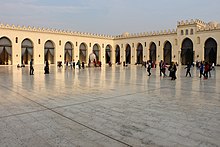
The Al-Hakim Mosque is named after Imam Al-Hakim bi-Amr Allah (985–1021), the third Fatimid caliph to rule in Egypt. Construction of the mosque started in 990 under Caliph al-Aziz. In 1002–3 Caliph al-Hakim ordered completion of the building. The southern minaret has an inscription with his name and the date of 393 (1003). Significant changes were made to the minarets in 1010, when the original towers were encased inside the large cuboid bastions seen today.[19][68] At first the mosque was outside the city walls, but when Badr al-Jamali rebuilt the walls he enclosed a larger area, and the north wall of the mosque became part of the new stone city wall. The mosque was badly damaged in the 1303 earthquake, and suffered further damage in later years. By the nineteenth century it was ruined, but it was heavily reconstructed in the 1980s.[19][68]
The mosque is an irregular rectangle with four arcades that surround the courtyard. As with the Ibn Tulun Mosque, the arches are pointed and rest on brick piers. It resembles the al-Azhar mosque in having three domes along the qibla wall, one at each corner and one over the mihrab. Also like al-Azhar, the prayer hall is crossed by a transept at right angles to the qibla.[19] This wide and tall central aisle leading to the prayer niche borrows from the Mahdiya mosque's design.[69] The al-Hakim mosque differs from the al-Azhar and Ibn Tulun mosques in having two stone minarets at the corners of the stone façade, which has a monumental projecting portal like the Mosque of Mahdiya.[19]
Al-Aqmar Mosque
The Aqmar Mosque was built in 1125 on the orders of vizier al-Ma'mun al-Bata'ihi during the caliphate of Imam Al-Amir bi-Ahkam Allah. The mosque is located on al-Muizz Street, north of Bayn al-Qasrayn, formerly adjacent to the palace of the Fatimid caliphs. It is notable for its façade, which is elaborately decorated with inscriptions, blind arches, muqarnas, and other symbols. It is the first mosque in Cairo to have such external decoration and also the first whose external façade is at a different angle than the alignment of the mosque's interior (which is oriented to the qibla) in order to follow the alignment of the street.[70][71][72] The interior of the mosque consists of a small courtyard surrounded by arcaded galleries and a hypostyle prayer hall. The arches are of keel shape and those facing the courtyard retain some of their original stucco decoration of Kufic inscriptions on arabesque backgrounds.[70] The mosque's minaret was added later during the Mamluk period. The building underwent a major renovation and reconstruction in the late 20th century, from which originate the present-day mihrab and the right-side (southern) half of the exterior façade.[71][70][73]
- Al-Aqmar Mosque
-
Exterior façade of al-Aqmar Mosque
-
Chamfered corner of al-Aqmar Mosque
-
Interior of al-Aqmar Mosque, courtyard and arches
-
Detail of the keel arches and stucco decoration
-
Prayer hall inside al-Aqmar Mosque
Other Cairo mosques
The
The Juyushi Mosque (discussed below in its role as a mashhad) was built by Badr al-Jamali, the "Amir al Juyush" (Commander of Forces) of the Fatimids. The mosque was completed in 1085 under the patronage of the then Caliph and Imam
The
Mausoleums and shrines

The
The
Two other important mashads from the Fatimid era in Cairo are those of Sayyida Ruqayya and Yayha al-Shabih, in the Southern Cemetery. Sayyida Ruqayya, a daughter of Ali, never visited Egypt, but the mashhad was built in 1033 to commemorate her. It is similar to al-Juyushi's, but with a larger, fluted dome.[82][83] The building today includes only a domed chamber preceded by a portico, but it was probably originally preceded by a courtyard.[83] Its most remarkable feature is its elegantly decorated mihrab of carved stucco, which scholar Doris Behrens-Abouseif describes as "one of the great masterpieces of stucco in Egypt".[84] The mihrab niche is shaped like a keel arch and has fluted ridges radiating from a central epigraphic medallion in the middle of its conch, a design which may have been inspired by the decorative niches of the façade of the al-Aqmar Mosque.[84][85][82]
Fortifications
Fortifications of Mahdia
After the Aghlabids came the Fatimids, who took over Ifriqiya in the early 10th century. Most notably, the Fatimids built a heavily-fortified new capital at Mahdia, located on a narrow peninsula extending from the coastline into the sea. The narrow land approach to the peninsula was protected by an extremely thick stone wall reinforced with square bastions and a round polygonal tower at either end where the wall met the sea. The only gate was the
Fortifications of Cairo
A new city wall was built around Cairo on the orders of the vizier Badr al-Jamali (r. 1074–1094). Cairo had expanded beyond the original city walls, and the city faced threats from the east, notably by the Turkoman
Al-Jamali, an Armenian in origin, is said to have employed Armenians from the north of Mesopotamia as well as
Al-Jamali preferred stone as the medium for his building works, introducing a new style into Cairo architecture.[88] All three gates have massive towers linked by curtain walls above the passageways. They introduced architectural features new to Egypt including the pendentives that support the domes above the passageways of the Bab al-Futuh and Bab Zuweila gates, and intersecting barrel vaults.[88] Use of semi-circular and horizontal arches, and lack of pointed arches, represented a departure from normal Fatimid architecture, probably taken from Syrian examples, and were never widely used during the Fatimid period. The use of stone also reflects Syrian tastes.[88]
The passageways through each of the gates are 20 metres (66 ft) long, and have vaulted ceilings with hidden machicolation openings in their ceilings. The lower part of each tower is of solid stone, while the upper third has a vaulted room with arrowslits.[89] An unusual feature of the wall near Bab al-Nasr is a stone latrine which appears like a balcony.[88] The wall between Bab al-Nasr and Bab al-Futuh contains an inscription of Quranic texts in Kufic characters.[91]
Bab al-Futuh
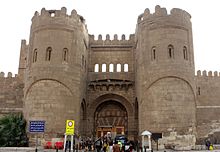
Bab al-Futuh is a gate in the north wall of the old city, built in 1087. It stands at the northern end of al-Mu'izz Street.[88] The name "Futuh" means "conquest".[92] the gate had rounded towers, with both of their façades incorporating a design of two parallel carved lines with loops between them. No earlier use of this decorative style is known, although it became common in the Mamluk period. There are carved brackets above the entrance arch, two of which have the head of a ram. This appears to be a survival of pre-Islamic symbolism.[92] However, Fatimid arabesques decorate the brackets.[88]
Bab al-Nasr

Bab al-Nasr is a massive fortified gate built in 1087 with rectangular stone towers. The name means "Gate of Victory". The entrance vestibule is cross-vaulted. There are two shallow domes over the upper levels of the towers. The walls are decorated with shields and swords, possibly Byzantine in design.[91] Many French inscriptions on Bab al-Nasr indicate use of the fort by Napoleon's soldiers, including "Tour Courbin" and "Tour Julien".[88]
Bab Zuweila
Bab Zuweila (or Zuwayla) is a medieval gate built in 1092. It is the last remaining southern gate from the walls of Fatimid Cairo.[93] The gate is today commonly called Bawabet El Metwalli.[94] Its name comes from bab, meaning "door", and Zuwayla, the name of a North African tribe. The towers are semi-circular. Their inner flanks have lobed arches as decorations, a North African motif introduced to Egypt by the Fatimids. The vestibule to the right contains a half-domed recess with elegantly carved arches at each corner.[90] The gates were massive, weighing four tons.[94] The gates today have two minarets, open to visitors, from which the area may be viewed.[95][g] Additions were made during the 15th century.[96]
Restorations and modern mosques
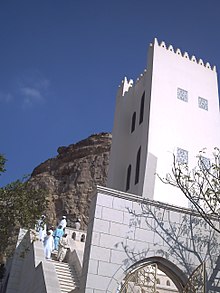
The Fatimid buildings have gone through many renovations and restructurings in different styles from the early Mamluk period to modern times.[97]
The Fakahani Mosque exemplifies this process. It was built in the Fatimid period, either as a suspended mosque (one with shops underneath it) or with a high basement.[98] After the earthquake of 1302 it was rebuilt. In 1440 an ablution basin was added, and early in the Ottoman period a minaret was built.[98] The amir Ahmad Katkhuda Mustahfazan al-Kharbutli in 1735 ordered a major reconstruction, almost all of the original building being replaced apart from two doors.[98] These finely carved doors were registered as a historical monument in 1908 by the committee of conservation, and the building itself was registered in 1937.[98][99]
The
In November 1979 the first newsletter of the Society for the Preservation of the Architectural Resources of Egypt wrote a scathing report of the Bohras' renovation of the al-Hakim mosque, saying "Though their method of financing the project is intriguing, their concrete arcades can only be deplored." However, when the mosque was re-opened a year later the
The restorations have significantly changed the buildings from their prior state. Helwan marble has been used extensively on both interior and exterior surfaces, and inscriptions in the interior have been gilded. Motifs and designs have been copied from one mosque to another. The qibla bay of the al-Hakim mosque, which had been irreparably damaged, was replaced by a version in marble and gilt of the mihrab of al-Azhar mosque.
See also
References
Notes
- ^ Ifriqiya was the western part of the Fatimid caliphate, covering the northern part of what today is western Libya, Tunisia and eastern Algeria.
- ^ The term "keel arch" comes from their shape resembling that of the keel of an upturned boat.
- ^ Fragments of stucco decoration have also been found during modern excavations at al-Mansuriyya, the Fatimid capital in Ifriqiya, but they may post-date the Fatimid occupation of the city.[3]
- ^ The carved stucco inside the mihrab's niche dates from the Fatimid period, but the stucco on the wall around it dates from a later Mamluk restoration by Sayf al-Din Salar after 1303.[61]
- ^ Suffa / ṣufūf: arcades.[67]
- ^ The Mosque of Sultan al-Muayyad, completed in 1421, was built beside the Bab Zuweila gate by the Sultan al-Muyyad. He destroyed part of the city wall to make room, and placed the minarets on the gateway rather than the mosque.[96]
Citations
- ^ a b Jarzombek & Prakash 2011, p. 384.
- ^ a b c d e Bloom & Blair 2009, p. 71.
- ^ a b c d e f Bloom 2012.
- ^ Behrens-Abouseif 1992.
- ^ Sanders 2008, p. 130.
- ^ Madraswala 2020, p. 142.
- ^ Madraswala 2020, p. 90.
- ^ Yeomans 2006, p. 43.
- ^ a b Yeomans 2006, p. 44.
- ^ a b c d e Petersen 2002, p. 168.
- ^ Hadda 2008, p. 72–73.
- ^ Halm 1996, p. 331, 345.
- ^ Ruggles 2011, p. 120.
- ^ Tracy 2000, p. 234.
- ^ Barrucand & Rammah 2009, p. 349.
- ^ a b Safran 2000, p. 68.
- ^ a b c d Cortese & Calderini 2006, p. 166.
- ^ a b Anderson & Pruitt 2017, p. 229.
- ^ a b c d e Behrens-Abouseif 1992, p. 63.
- ^ Anderson & Pruitt 2017, p. 243.
- ^ a b Cortese & Calderini 2006, p. 167.
- ^ Cortese & Calderini 2006, p. 170.
- ^ a b Bloom 2008, p. 231.
- ^ Behrens-Abouseif 1992, p. 9.
- ^ a b c d e Petersen 2002, p. 45.
- ^ Daftary 1990, p. 254.
- ^ Dadoyan 1997, p. 147.
- ^ a b The Art of the Fatimid Period.
- ^ a b c Kuiper 2009, p. 164.
- ^ a b c d Lapidus 2002, p. 285.
- ^ Fage 1975, p. 22.
- ^ Kuban 1974, p. 1.
- ^ a b Kuiper 2009, p. 165.
- ^ a b c d e f g h i j k l m n o Behrens-Abouseif 1992, p. 10.
- ^ Petersen 2002, p. 44.
- ^ Arnold 2017.
- ^ a b c d e f g Arnold 2017, pp. 37–40.
- ^ a b Bloom 2020, pp. 48–49.
- ^ Arnold 2017, p. 41.
- ^ a b c Bloom 2020, pp. 58–61.
- ^ Raymond 1993, pp. 55–59.
- ^ Raymond 1993, p. 57.
- ^ Behrens-Abouseif 2018, pp. 44–45.
- ^ Lapidus 2002, p. 286.
- ^ Arnold 2017, p. 53.
- ^ Bloom 2020, p. 67.
- ^ a b Arnold 2017, p. 50–52.
- ^ Robinson 1996, p. 269.
- ^ a b Fatimid Mosques in Cairo - MIT.
- ^ a b Bloom 1988, p. 8.
- ^ a b c Bloom 2020, pp. 49–51.
- OCLC 856037134.
- ^ Petersen 2002, pp. 187–188.
- ISBN 978-0-7486-4682-1.
- ^ Rabbat 1996, p. 50.
- ^ a b Sanders 2004, p. 141.
- ^ Hadda 2008, p. 72.
- ^ Holbrook, Medupe & Urama 2008, p. 155.
- ^ Ettinghausen 1972, p. 58.
- ^ Petersen 2002, p. 86–87.
- ^ Behrens-Abouseif 1992, p. 60.
- ^ a b Fatimid Architecture.
- ^ a b c d Behrens-Abouseif 1992, p. 58.
- ^ Homerin 2001, p. 347.
- ^ Wijdan 1999, p. 142.
- ^ a b Behrens-Abouseif 1992, p. 59.
- ^ a b c d Bloom 1988, p. 7.
- ^ a b O'Kane 2016, pp. 16–17.
- ^ Yeomans 2006, p. 59.
- ^ a b c d O'Kane 2016, p. 29–31.
- ^ a b c Williams 2018, p. 235–237.
- ^ Doris Behrens-Abouseif, “The Façade of the Aqmar Mosque in the Context of Fatimid Ceremonial,” Muqarnas 9 (1992), 35.
- ^ Behrens-Abouseif 2018, pp. 58–60.
- ^ Masjid al-Lu'lu'a.
- ^ Williams 2008, p. 128–129.
- ^ Saifuddin 2002.
- ^ Raymond 1993, p. 65.
- ^ Cortese & Calderini 2006, p. 164.
- ^ Behrens-Abouseif 1992, p. 66.
- ^ a b c O'Kane 2016, pp. 22–23.
- ^ Behrens-Abouseif 1992, p. 67.
- ^ a b Petersen 2002, p. 45–46.
- ^ a b Behrens-Abouseif 1992, p. 74.
- ^ a b Behrens-Abouseif 1992, p. 75.
- ^ Williams 2018, p. 146.
- ^ Marçais, Georges (1954). L'architecture musulmane d'Occident. Paris: Arts et métiers graphiques. pp. 89–91.
- ^ Bloom 2020, p. 47.
- ^ a b c d e f g h i Bab al-Nasr - Archnet.
- ^ a b Petersen 2002, p. 89.
- ^ a b c Behrens-Abouseif 1992, p. 72.
- ^ a b Behrens-Abouseif 1992, p. 68.
- ^ a b Behrens-Abouseif 1992, p. 69.
- ^ Eyewitness Travel: Egypt, p. 103.
- ^ a b Hebeishy 2010, p. 217.
- ^ Firestone 2010, p. 136.
- ^ a b Hurley & Ennis 2002, p. 97.
- ^ Sanders 2008, p. 122.
- ^ a b c d Bloom 2008, p. 234–235.
- ^ Bloom & Blair 2009, p. 330.
- ^ Sanders 2008, p. 116.
- ^ al Sayyad 2011, p. 57.
- ^ Sanders 2008, p. 117.
- ^ Sanders 2008, p. 118.
- ^ Sanders 2008, p. 126.
- ^ Sanders 2008, p. 127.
- ^ Kerr 2002, p. 69.
Sources
- Anderson, Glaire D.; Pruitt, Jennifer (2017). "The Three Caliphates, a Comparative Approach". In Flood, Finbarr Barry; Necipoğlu, Gülru (eds.). A Companion to Islamic Art and Architecture. Vol. 1. Wiley Blackwell. pp. 223–249. ISBN 9781119068662.
- "Bab al-Nasr". Archnet.org. Archived from the original on 29 September 2012. Retrieved 8 March 2013.
- Arnold, Felix (2017). Islamic Palace Architecture in the Western Mediterranean: A History. Oxford University Press. ISBN 9780190624552.
- Barrucand, Marianne; Rammah, Mourad (2009). Necipoğlu, Gülrü (ed.). "Sabra al-Mansuriyya and Her Neighbors during the First Half of the Eleventh Century: Investigations into Stucco Decoration". Muqarnas, an Annual on Islamic Art and Architecture. 26. Leiden: Brill: 349–376. ISBN 978-90-04-17589-1.
- Behrens-Abouseif, Doris (1992). Islamic Architecture in Cairo: An Introduction. Brill. ISBN 978-90-04-09626-4. Retrieved 2013-03-05.
- Behrens-Abouseif, Doris (2018). "The Fatimid Dream of a New Capital: Dynastic Patronage and Its Imprint on the Architectural Setting". In Melikian-Chirvani, Assadullah Souren (ed.). The World of the Fatimids. Toronto; Munich: Aga Khan Museum; The Institute of Ismaili Studies; Hirmer. pp. 44–67.
- ISBN 978-90-04-08155-0.
- Bloom, Jonathan M. (2007). Arts of the City Victorious: Islamic Art and Architecture in Fatimid North Africa and Egypt. New Haven and London: ISBN 978-0-300-13542-8.
- Bloom, Jonathan M. (2008). Necipoğlu, Gülrü (ed.). "The "Fatimid" Doors of the Fakahani Mosque in Cairo". Muqarnas, an Annual on Islamic Art and Architecture. 25. Leiden: Brill: 231–242. ISBN 978-90-04-17327-9.
- Bloom, Jonathan M.; Blair, Sheila (2009). The Grove Encyclopedia of Islamic Art and Architecture: Delhi to Mosque. Vol. 2. Oxford University Press. ISBN 978-0-19-530991-1.
- Bloom, Jonathan M. (2012). "Fāṭimid art and architecture". In Fleet, Kate; ISSN 1873-9830.
- Bloom, Jonathan M. (2020). Architecture of the Islamic West: North Africa and the Iberian Peninsula, 700–1800. New Haven and London: Yale University Press. ISBN 978-0-300-21870-1.
- Cortese, Delia; Calderini, Simonetta (2006). Women And the Fatimids in the World of Islam. Edinburgh University Press. ISBN 978-0-7486-1733-3.
- ISBN 978-90-04-10816-5.
- ISBN 978-0-521-37019-6.
- Ettinghausen, Richard (1972). From Byzantium to Sasanian Iran and the Islamic World: Three Modes of Artistic Influence. Brill Archive. p. 58. ISBN 978-90-04-03509-6. Retrieved 2013-03-10.
- Eyewitness Travel: Egypt. London: Dorlin Kindersley Limited. 2007 [2001]. ISBN 978-0-7566-2875-8.
- Fage, John D. (1975). The Cambridge History of Africa. Cambridge University Press. p. 22. ISBN 978-0-521-20981-6.
- "Fatimad Architecture". History for kids organization. Archived from the original on 26 January 2013. Retrieved 7 March 2013.
- "Fatimid Mosques in Cairo". Massachusetts Institute of Technology. Retrieved 2013-03-08.
- Firestone, Matthew (2010). Egypt. Lonely Planet. p. 136. ISBN 978-1-74220-332-4. Retrieved 2013-03-09.
- Hadda, Lamia (2008). Nella Tunisia medievale. Architettura e decorazione islamica (IX-XVI secolo). Naples: Liguori editore. ISBN 978-88-207-4192-1.
- ISBN 90-04-10056-3.
- Hebeishy, Mohamed el (2010). Frommer's Egypt. John Wiley & Sons. p. 217. ISBN 978-0-470-90682-8. Retrieved 2013-03-09.
- Holbrook, Jarita Charmian; Medupe, Rodney Thebe; Urama, Johnson O. (2008). African Cultural Astronomy: Current Archaeoastronomy and Ethnoastronomy Research in Africa. Springer. p. 155. ISBN 978-1-4020-6639-9. Retrieved 2013-03-10.
- Homerin, Th. Emil (2001). Umar ibn al-Fāriḍ. Paulist Press. ISBN 978-0-8091-0528-1. Retrieved 2013-03-10.
- Hurley, Frank; Ennis, Helen (2002). Man with a Camera: Frank Hurley Overseas. National Library Australia. ISBN 978-0-642-10737-4.
- Jarzombek, Mark M.; Prakash, Vikramaditya (2011). A Global History of Architecture. John Wiley & Sons. ISBN 978-0-470-90245-5.
- Kerr, Ann Zwicker (2002). Painting the Middle East. Syracuse University Press. ISBN 978-0-8156-0752-6.
- Kuban, Doğan (1974). Muslim Religious Architecture: Development of Religious Architecture in Later Periods. BRILL. ISBN 978-90-04-07084-4.
- Kuiper, Kathleen (2009). Islamic Art, Literature, and Culture. The Rosen Publishing Group. ISBN 978-1-61530-097-6.
- Lapidus, Ira M. (2002). A History of Islamic Societies. Cambridge University Press. ISBN 978-0-521-77933-3.
- "Masjid al-Lu'lu'a". Archnet. Archived from the original on 29 June 2011. Retrieved 3 December 2010.
- O'Kane, Bernard (2016). The Mosques of Egypt. American University of Cairo Press. ISBN 9789774167324.
- Petersen, Andrew (2002). Dictionary of Islamic Architecture. Taylor & Francis. ISBN 978-0-203-20387-3.
- Rabbat, Nasser (1996). Necipoğlu, Gülrü (ed.). "Al-Azhar Mosque: An Architectural Chronicle of Cairo's History". Muqarnas, an Annual on Islamic Art and Architecture. 13. Leiden: E.J. Brill: 45–67. ISBN 978-90-04-10633-8.
- Raymond, André (1993). Le Caire (in French). Fayard.
- Robinson, Francis (1996). The Cambridge Illustrated History of the Islamic World. Cambridge University Press. p. 269. ISBN 978-0-521-66993-1.
- Ruggles, D. Fairchild (2011). Islamic Art and Visual Culture: An Anthology of Sources. John Wiley & Sons. ISBN 978-1-4051-5401-7.
- Safran, Janina M. (2000). The Second Umayyad Caliphate: The Articulation of Caliphal Legitimacy in Al-Andalus. Harvard CMES. ISBN 978-0-932885-24-1.
- Saifuddin, Ja'far us Sadiq Mufaddal (2002). Al Juyushi: A Vision of the Fatemiyeen. Graphico Printing Limited. ISBN 978-0-9539270-1-2.
- Sanders, Paula (2004). "The Contest over Context: Fatimid Cairo in the Twentieth Century". Giorgio Levi Della Vida Conferences. Garnet & Ithaca Press. ISBN 978-0-86372-298-1.
- Sanders, Paula (2008). Creating Medieval Cairo: Empire, Religion, and Architectural Preservation in Nineteenth-Century Egypt. American Univ in Cairo Press. ISBN 978-977-416-095-0.
- al Sayyad, Nezar (30 September 2011). Cairo. Harvard University Press. ]
- "The Art of the Fatimid Period (909–1171)". The Metropolitan Museum of Art. Retrieved 7 March 2013.
- Tracy, James D. (2000). City Walls: The Urban Enceinte in Global Perspective. Cambridge University Press. ISBN 978-0-521-65221-6.
- ISBN 978-977-424-476-6.
- Williams, Caroline (2008). Islamic Monuments in Cairo: The Practical Guide (6th ed.). Cairo: The American University in Cairo Press. ISBN 978-977-416-205-3.
- Williams, Caroline (2018). Islamic Monuments in Cairo: The Practical Guide (7th ed.). Cairo: The American University in Cairo Press. ISBN 978-977-416-855-0.
- Yeomans, Richard (2006). The art and architecture of Islamic cairo. Garnet & Ithaca Press. ISBN 978-1-85964-154-5.
- Madraswala, Aliasger Najam (2020). The Iḥyāʾof al-Jāmiʿal-Anwar: Religious Values in the Restoration of Sacred Islamic Monuments (PDF) (PhD thesis). (PDF) from the original on 13 June 2021. Retrieved 23 August 2020 – via Research Archive and Digital Asset Repository.




